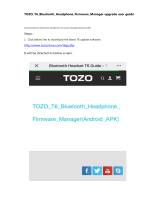
Table of Contents
1 Introduction ......................................................................................................... 1
1.1 Summarization ............................................................................................................................. 1
1.2 Check Package Content ................................................................................................................ 1
1.3 Connection .................................................................................................................................. 1
2 Installation .......................................................................................................... 2
2.1 Install IP-CAM to Ethernet Network ...................................................................................... 2
2.2 CMS and IP-Tool Installation ................................................................................................ 2
3 IE Remote Access ................................................................................................. 3
3.1 LAN ................................................................................................................................... 3
3.1.1 Access through IP-Tool ........................................................................................ 3
3.1.2 Directly Access through IE .................................................................................... 4
3.2 WAN .................................................................................................................................. 6
4 Remote Preview ................................................................................................... 7
4.1 The Remote Preview Interface .............................................................................................. 7
4.2 Record Playback .................................................................................................................. 7
4.3 Right-click Function ............................................................................................................ 8
4.4 Snap Pictures....................................................................................................................... 8
5 Remote Live Surveillance ................................................................................... 10
5.1 System Configuration ......................................................................................................... 10
5.1.1 Basic Information .............................................................................................. 10
5.1.2 Date & Time Configuration ................................................................................. 11
5.2 Video Configuration ........................................................................................................... 11
5.2.1 Camera Configuration ........................................................................................ 11
5.2.2 Video Stream ..................................................................................................... 12
5.2.3 Time Stamp ....................................................................................................... 12
5.2.4 Video Mask ....................................................................................................... 13
5.3 Alarm Configuration .......................................................................................................... 13
5.3.1 Motion Detection Area ....................................................................................... 13
5.3.2 Motion Detection Trigger .................................................................................... 14
5.3.3 Motion Detection Schedule ................................................................................. 15
5.4 Network Configuration ....................................................................................................... 15
5.4.1 Port .................................................................................................................. 15
5.4.2 Wired ................................................................................................................ 16
5.4.3 NET Traversal Configuration .............................................................................. 16
5.4.4 Server Configuration .......................................................................................... 17
5.4.5 IP Notify ........................................................................................................... 18
5.4.6 DDNS Configuration .......................................................................................... 18
5.4.7 RTSP ................................................................................................................ 22
5.4.8 UPNP ............................................................................................................... 22
5.4.9 Mail Setting ....................................................................................................... 23
5.4.10 FTP .................................................................................................................. 24
5.5 Advanced Configuration ..................................................................................................... 24
5.5.1 User Configuration ............................................................................................. 25
5.5.2 Security Configuration........................................................................................ 26
5.5.3 Configure Backup & Restore ............................................................................... 27
5.5.4 Reboot Device ................................................................................................... 27
5.5.5 Upgrade ............................................................................................................ 28
6 Mobile Surveillance ........................................................................................... 29
6.1 Network Configuration ....................................................................................................... 29
6.2 By Phones with iPhone OS ................................................................................................. 30
6.3 By Phones with Android ................................................................................................... 36
7 Use method for IP-TOOL ................................................................................... 39
8 Q & A ................................................................................................................ 42
9 Specification ...................................................................................................... 44





















